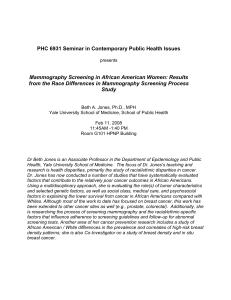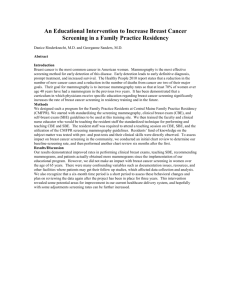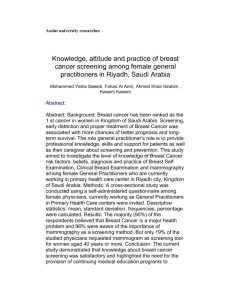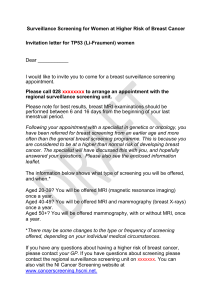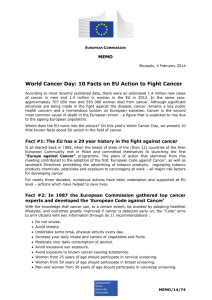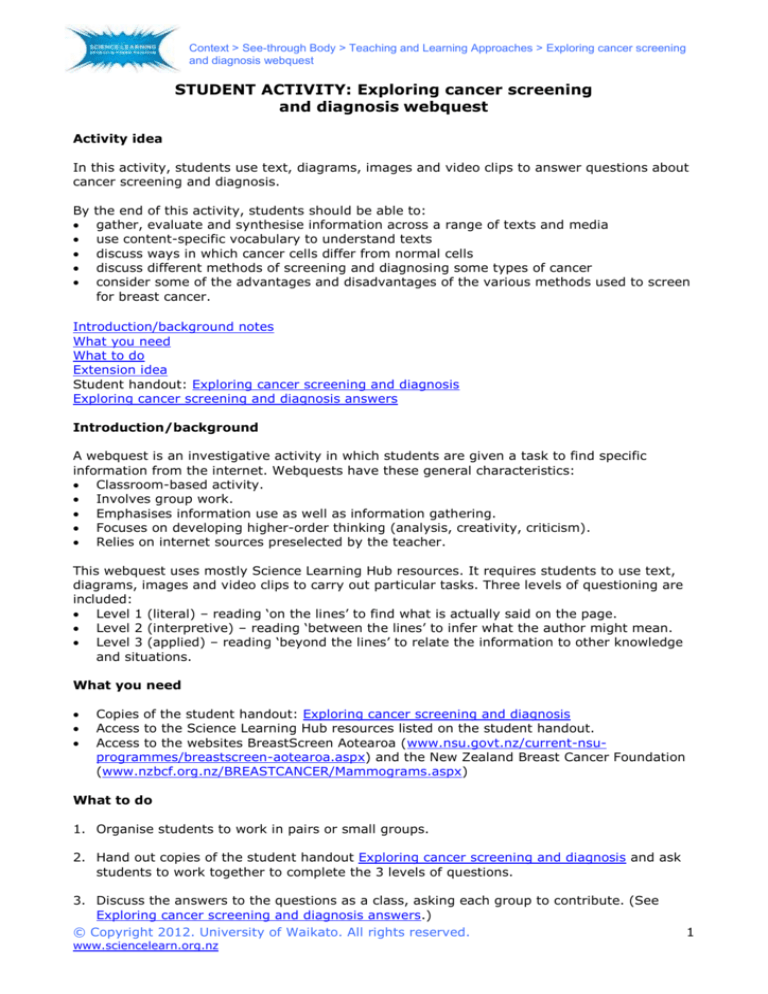
Context > See-through Body > Teaching and Learning Approaches > Exploring cancer screening
and diagnosis webquest
STUDENT ACTIVITY: Exploring cancer screening
and diagnosis webquest
Activity idea
In this activity, students use text, diagrams, images and video clips to answer questions about
cancer screening and diagnosis.
By
the end of this activity, students should be able to:
gather, evaluate and synthesise information across a range of texts and media
use content-specific vocabulary to understand texts
discuss ways in which cancer cells differ from normal cells
discuss different methods of screening and diagnosing some types of cancer
consider some of the advantages and disadvantages of the various methods used to screen
for breast cancer.
Introduction/background notes
What you need
What to do
Extension idea
Student handout: Exploring cancer screening and diagnosis
Exploring cancer screening and diagnosis answers
Introduction/background
A webquest is an investigative activity in which students are given a task to find specific
information from the internet. Webquests have these general characteristics:
Classroom-based activity.
Involves group work.
Emphasises information use as well as information gathering.
Focuses on developing higher-order thinking (analysis, creativity, criticism).
Relies on internet sources preselected by the teacher.
This webquest uses mostly Science Learning Hub resources. It requires students to use text,
diagrams, images and video clips to carry out particular tasks. Three levels of questioning are
included:
Level 1 (literal) – reading ‘on the lines’ to find what is actually said on the page.
Level 2 (interpretive) – reading ‘between the lines’ to infer what the author might mean.
Level 3 (applied) – reading ‘beyond the lines’ to relate the information to other knowledge
and situations.
What you need
Copies of the student handout: Exploring cancer screening and diagnosis
Access to the Science Learning Hub resources listed on the student handout.
Access to the websites BreastScreen Aotearoa (www.nsu.govt.nz/current-nsuprogrammes/breastscreen-aotearoa.aspx) and the New Zealand Breast Cancer Foundation
(www.nzbcf.org.nz/BREASTCANCER/Mammograms.aspx)
What to do
1. Organise students to work in pairs or small groups.
2. Hand out copies of the student handout Exploring cancer screening and diagnosis and ask
students to work together to complete the 3 levels of questions.
3. Discuss the answers to the questions as a class, asking each group to contribute. (See
Exploring cancer screening and diagnosis answers.)
© Copyright 2012. University of Waikato. All rights reserved.
www.sciencelearn.org.nz
1
Context > See-through Body > Teaching and Learning Approaches > Exploring cancer screening
and diagnosis webquest
Extension idea
This webquest could be run by setting the following scenario.
Imagine you’re a journalist working for an online newspaper and the editor has asked you
to find out more about medical imaging for an article on the screening and diagnosis of
breast cancer. The editor has recommended certain articles/video clips to find out what
scientists and doctors are working on.
Your task is to work through the questions and use the answers as the basis for your
article.
The article should begin with an overview on what is a cancerous cell. It should discuss
some of the advantages, disadvantages and precautions concerning medical imaging.
Finish the article with comments involving the level 3 questions.
Your article should be limited to 600 words.
© Copyright 2012. University of Waikato. All rights reserved.
www.sciencelearn.org.nz
2
Context > See-through Body > Teaching and Learning Approaches > Exploring cancer screening
and diagnosis webquest
Student handout: Exploring cancer screening and diagnosis
Level 1
Use these resources to answer the questions:
How do people find out that they have cancer?
Cells and cancer
What is the DIET project?
Digital camera technology
Science Learning Hub Glossary
1. How do cancer cells differ from normal cells?
2. What is the difference between screening and diagnosis of cancer?
3. Describe the tomography (DIET) technique that is being used at the University of
Canterbury to screen for breast cancer.
Level 2
Use these resources to answer the questions:
X-ray imaging
Computed tomography (CT)
Improving breast cancer detection
Screening for breast cancer
4. What makes it difficult to detect lumps or tumours in breasts?
5. What are the limitations of using X-rays for screening for cancer?
6. What safety precautions are necessary when using X-rays?
7. What other medical imaging techniques could be used for diagnosing any cancerous tissue?
Level 3
Use these resources to answer the questions:
What is the DIET project?
Screening for breast cancer
Improving breast cancer detection
How do people find out that they have cancer?
BreastScreen Aotearoa website
NZ Breast Cancer Foundation website
8. Why do you think women might prefer to be screened for breast cancer using the digital
tomography rather than mammography?
© Copyright 2012. University of Waikato. All rights reserved.
www.sciencelearn.org.nz
3
Context > See-through Body > Teaching and Learning Approaches > Exploring cancer screening
and diagnosis webquest
Exploring cancer screening and diagnosis answers
Level 1
1. How do cancer cells differ from normal cells?
A cancer cell differs in its appearance and its behaviour.
Cancer cells often have an enlarged nucleus.
They are often proliferating in a very disorganised way.
They tend to take over the body’s tissues and grow without being regulated.
2. What is the difference between screening and diagnosis of cancer?
Cancer screening involves regularly testing people who don’t otherwise have any
symptoms.
Diagnosis is the identification of disease through the examination of the person’s
symptoms.
3. Describe the tomography (DIET) technique that is being used at the University of
Canterbury to screen for breast cancer.
Digital image-based elasto-tomography (DIET) uses digital cameras to image motion on
the outside of the body to work out what is going on in the tissue underneath.
The DIET project is to develop a breast cancer screening technique. They’re looking at the
idea of imaging elasticity. As cancer tissue is much stiffer than healthy tissue, if you can
image elasticity, you should really see the cancer quite clearly.
Level 2
4. What makes it difficult to detect lumps or tumours in breasts?
Feeling the breasts (breast self-examination) for an unusual lump is tricky as it’s like
feeling for a small marble in a wrapped present.
When you have a mammogram, you’re actually imaging radio density, and as radio density
doesn’t necessarily vary a great deal between cancerous tissue and healthy tissue, you’re
not actually looking for obvious image contrast. You’re looking at very subtle changes in
the structure of the image itself, so you need highly trained experts – radiographers – to
read these mammogram images and try and see if there is cancer in there.
Mammograms can also be uncomfortable for some women, and they avoid attending
regularly. One of the key parts of any breast screening process is that the images are
taken at regular intervals so that radiographers can compare this year’s image to last
year’s. So if women are skipping appointments and images are not taken on a regular
basis, then some of the benefits of a screening methodology are removed.
5. What are the limitations of using X-rays for screening for cancer?
X-rays are good for showing dense tissues that absorb the X-rays. They can be used for
some soft tissue investigations (such as looking for lung disease). Sometimes dyes can be
injected to help visualise other parts of the body (such as arteries) with X-rays.
However, X-rays are not useful when trying to look at other types of soft tissue, for
example, muscle or the brain. Cancer in these tissues/organs must be visualised by other
methods.
© Copyright 2012. University of Waikato. All rights reserved.
www.sciencelearn.org.nz
4
Context > See-through Body > Teaching and Learning Approaches > Exploring cancer screening
and diagnosis webquest
6. What safety precautions are necessary when using X-rays?
X-rays can causes illness in the people performing the X-ray and in the person receiving
the X-ray. To keep everyone safe, steps have been taken to control the availability of X-ray
equipment, to make sure all radiographers are trained and find out what the safe levels of
exposure are.
7. What other medical imaging techniques could be used for diagnosing any cancerous tissue?
CT (computed tomography or computed axial tomography) is a way of scanning the whole
body, or part of the body, slice by slice, using the principles of X-ray. CT is able to
differentiate between different types of tissues. CT scans offer far more detailed images of
lungs, bones, blood vessels and other body tissues than a conventional X-ray. They can be
used to screen for cancer, tumours and blood clots and also investigate heart disease.
Level 3
8. Why do you think women might prefer to be screened for breast cancer using digital
tomography rather than mammography?
Screening mammograms are provided free for all New Zealand women between the ages of
45 and 69. Some women find mammograms uncomfortable as the breast is pressed firmly
between two plates to get a good image, and they avoid regular mammograms because of
this discomfort. Also, for women under 50, screening mammograms pick up fewer lumps
because of their relatively denser breast tissue.
The DIET should be a relatively comfortable imaging process, so there wouldn’t necessarily
be any reason for a woman to avoid going. The DIET project developers also propose that,
because this screening process is cheap, the screening could be done once or twice a year
rather than every 2 years (as with screening mammograms). This may make it a more
effective screening programme for breast cancer detection than mammograms.
© Copyright 2012. University of Waikato. All rights reserved.
www.sciencelearn.org.nz
5


